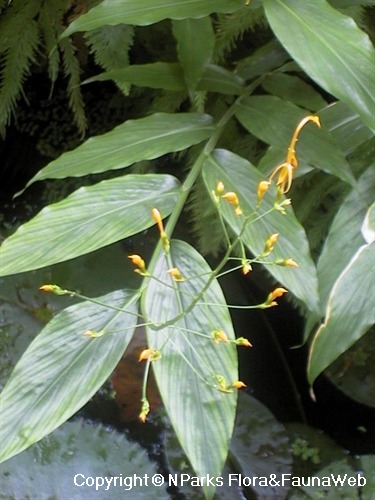
Back
Globba winitii
| Family Name: | Zingiberaceae |
| Common Name: | Dancing Lady Ginger, Mauve Dancing Ladies, Dancing Girl, 美苞舞花姜 |
Name
Classifications and Characteristics
| Plant Division | Angiosperms (Flowering Seed Plants) (Dicotyledon) |
|---|---|
| Plant Growth Form | Herbaceous Plant |
| Lifespan (in Singapore) | Perennial |
| Maximum Height | 0.6 m |
Biogeography
| Native Distribution | Thailand |
|---|---|
| Native Habitat | Terrestrial (Primary Rainforest) |
| Preferred Climate Zone | Tropical |
Description and Ethnobotany
| Others - Plant Morphology | Growth Form: Evergreen, rhizomatous herb that forms loose clumps. Habitat: Occurs in the understorey of forests in Southeast Asia. It is very rare due to overexploitation for the horticultural industry. Foliage: Leaves are long and lanceolate (20 - 25 cm long) with entire leaf margins. Leaves are glabrous above, but lightly pubescent below. It may be distinguished from named varieties by the presence of cordate leaf bases. Flowers: The inflorescence is a raceme that hangs downwards. Magenta, ovate bracts overlap one another and partially cover the floral stalk. Each flower is borne on a long purple stalk that is held perpendicular to the main axis of the inflorescence. Small, yellow flowers (2 - 3 cm long) are tubular with a single, elongated and arched stamen. The blooming period lasts for about a month. Fruits: Fruits are capsules. Seeds have a fleshy covering. Landscaping: This species is often planted for its attractive inflorescences. The purple bracts and yellow flowers provide striking contrast, while the pendent inflorescence rocks gracefully in the wind. It should be planted in the front of borders due to its short stature. The unique inflorescences are sure to attract interest, so consider planting them near a pathway or sidewalk for easy access. It makes an ideal accent plant for gardens in partly shady areas. Cultivation: Plant in slightly acidic soil enriched with humus and having good drainage. For potted plants, you can use a 1:2:1 mixture of peat moss, loam and sand / perlite, respectively. In tropical climates, it is best to grow this species in full shade to prevent the leaves from being scorched by the sun. This species is typically resistant to pests. Propagation: Propagate by dividing clumps or cutting the dormant rhizome into pieces. Plants may also be started from seed. Plant seeds in equal parts of peat moss and sand and incubate at 18 - 22 degrees Celsius. Seeds will germinate in about 3 weeks. Etymology: The genus "Globba" is a Latin version of "galoba" meaning ginger in the Amboinese language. The specific epithet "winitii" was named after Phya Winit Wanandorn, a famous Thai botanist who studied forest plant species. |
|---|---|
| Ethnobotanical Uses | Others: The unusual flowers are ideal for floral arrangements, because they remain fresh for about 2 weeks after being cut. |
Landscaping Features
| Desirable Plant Features | Ornamental Flowers |
|---|---|
| Landscape Uses | Container Planting, Interiorscape/ Indoor Plant |
Plant Care and Propagation
| Light Preference | Semi-Shade |
|---|---|
| Water Preference | Lots of Water |
Foliar
| Foliage Retention | Evergreen |
|---|---|
| Mature Foliage Colour(s) | Green |
| Mature Foliage Texture(s) | Smooth, Thin |
| Foliar Type | Simple / Unifoliate |
| Foliar Shape(s) | Non-Palm Foliage (Lanceolate) |
| Foliar Venation | Pinnate / Net |
| Foliar Margin | Entire - Wavy / Undulate |
| Foliar Apex - Tip | Acute |
| Foliar Base | Cordate |
| Typical Foliar Area | Mesophyll ( 45cm2 - 182.25 cm2 ) |
| Leaf Area Index (LAI) for Green Plot Ratio | 3.5 (Shrub & Groundcover - Monocot) |
Floral (Angiosperm)
| Flower Colour(s) | Purple, Yellow / Golden |
|---|
Image Repository
Others
| Master ID | 739 |
|---|---|
| Species ID | 2034 |
| Flora Disclaimer | The information in this website has been compiled from reliable sources, such as reference works on medicinal plants. It is not a substitute for medical advice or treatment and NParks does not purport to provide any medical advice. Readers should always consult his/her physician before using or consuming a plant for medicinal purposes. |












